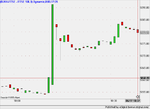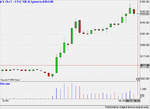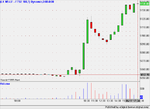QK…
I would agree – Having had time to think about it (and look at the charts again), it does look like something happened to drive the price higher.
If I remember correctly, the settlement priced used to be derived directly from the levels traded in the cash market between 10am – 10.30am. This settlement method appears to have been dispensed with, and replaced by this auction business, late last year.
Having seen Friday’s action and, therefore having thought about the issues more deeply, it is slightly more obvious that there is a huge potential for manipulation of the final price. As you yourself have commented, it almost looks like someone cornered the market and forced prices higher. You ask about the contract in question – As far as I can see it was simply the June (ZM5) FTSE100 Futures contract which showed explosive volumes.
My take on the price movement would be as follows…
FTSE has been fairly range bound of late so people have been writing strangles (selling Puts & Calls) with strikes at the range extremes and collecting fairly easy money. In the week or two leading into expiry FTSE started to break upwards penetrating the topside of its established range. This is obviously a danger for the Call writers who start to find that they are now short of In The Money Calls. This is the potential ‘set up’. If, moving into expiry, we edge higher, there is going to be an obvious demand for the June Futures as the Call writers look to hedge their Calls against potential bigger loses. Therefore you have a situation were a potential ‘avalanche’ can occur – the more people who start to hedge their Calls the more demand there is for the June Future and therefore the higher the price goes and, in turn, this causes even more people to cover. All that is requires is an initial series of large buys which trigger the chain of events to unfold.
The ‘glitch’ in the settlement procedure appears to be that there is no correlation between the settlement price and the underlying index on which the derivative is based. This, in my opinion, is a fundamental flaw. Sure a ‘derivative product’ must have a price which is ‘derived’ ?? If the final settlement is not a derived price, based on its underlying index, then it isn’t really a ‘derivative product’ – It’s a product like any other stock where its price (including its final settlement price) is arrived at purely based on supply / demand (and hence price) at a given moment in time.
I would have to suggest that the old settlement procedure was better simply because, even though it could be volatile, it appears a much fairer and less open to potential manipulation. As I already said, this current method seems to lack integrity.
Steve.



